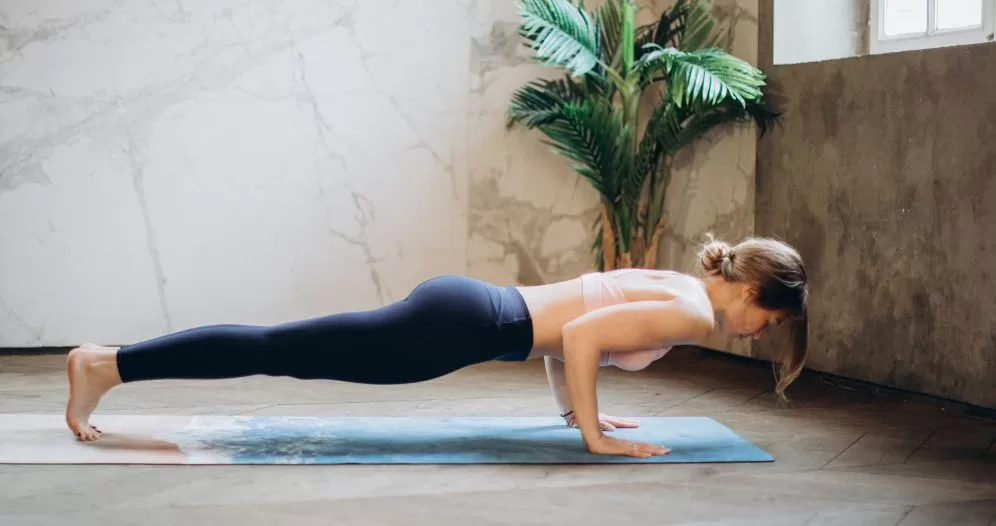How to Plank the Right Way

By incorporating planks into your abdominal workout routine, you can enjoy a multitude of benefits, particularly in strengthening your core.
A stable and strong core is crucial to overall fitness, and planks provide an effective means to achieve this. Take a few moments to read on and discover the different types of plank exercises along with their corresponding instructions, as well as the various benefits that come with them.
Here are a couple of tips on how to correctly execute a “plank”.
When you do a plank, focus on your breathing! First, make sure you don’t hold your breath. Second (and just as important!), make sure you’re not breathing “shallow” breaths.
By paying attention to your breath, you can hold the position longer – but you’ll also be strengthening those deep core muscles (i.e., your body working the way it is meant to … while breathing!).
The benefits of planking
Did you know that planking offers a range of physical benefits? Strengthening your core is crucial for any workout routine and can help you achieve a solid and healthy appearance. Moreover, a strong core is essential for stabilizing, balancing, and powering your body during other activities.
In fact, it is the foundation for all coordinated and powerful athletic movements. By reducing stress on your joints and improving your posture, a strong core can also enhance your overall physical performance. If you’re looking to test your core muscle strength and stability, consider the plank exercise.
Although it’s primarily a strength-building exercise, it can also help you burn calories by engaging multiple muscle groups. Studies have also been done on how these exercises can help reduce blood pressure.
How to perform a plank exercise
Find a space where you can stretch out your entire body. Using an exercise mat will help you feel more comfortable while on all fours. You can decide whether to do a plank on your palms or forearms.
- Assume the plank position by placing your forearms and toes on the floor while facing downwards. Make sure your elbows are positioned directly beneath your shoulders, and your forearms are facing forward. Your head should be relaxed, and your gaze should be focused on the floor.
- To maintain proper form, engage your abdominal muscles by pulling your navel towards your spine. Keep your torso straight and rigid with no sagging or bending, ensuring your body is in a straight line from your ears to your toes. Make sure your shoulders are down and not creeping up towards your ears. Additionally, position your heels over the balls of your feet. This is known as the neutral spine position.
- Hold this position for 10 seconds. Release to the floor.
- Over time work up to 30, 45, or 60 seconds.
Common issues to watch
To get the most out of these exercises and to reduce the possibility of strain or injury, avoid the following errors when performing the plank.
- Arching your back: Avoid arching your back during exercise to engage your abdominals effectively. Keep your shoulders down and wide for proper form and to avoid placing unnecessary weight on your arms.
- Sagging Hips: If your hips sink during a plank, it's time to stop. If they sag from the start, widen your stance and focus on engaging your abs.
- Tilting your head up: Your neck should be in line with your body, not tilted up, which could strain the neck. Keep your gaze down at the floor.
Variations and Modifications
If the plank exercise is challenging for you initially, you can attempt two different variations to develop your strength. There are numerous plank variations that target the core muscles to improve your stability and strength. Moreover, modifications are available for those who are new to the exercise.
Knee Plank / Tabletop Plank

This variation is a regression to the method described above. It is easier to manage and can be a stepping stone to a full plank.
To properly execute a plank from a tabletop position, actively press into your hands and pull in your abs. This will help you maintain a neutral spine, as shown in the picture. For an added challenge, tuck your toes under and lift your knees slightly off the floor. If you’re new to planking or experiencing foot pressure, try bending your knees while lifting them to build core strength and alleviate stress on your feet.
Feel like being challenged?
Try these variations if you feel like stepping it up bit.
- Plank with a Leg Lift
To do a plank with a leg lift, begin by positioning yourself in a plank stance with your forearms and toes on the ground. If you find the exercise too challenging, you may switch to your hands instead of your forearms.
- Slowly raise one leg 10 to 20 cm off the floor.
- Count to two and slowly lower your leg to the floor.
- Switch legs and repeat.
- Do two to three sets of 10 reps.
- Plank with an Arm Lift
If you want to switch up your regular plank routine, try adding an arm lift. You can do this by pushing into your opposite forearm or palm. Here are the steps to perform a plank with an arm lift:
- Start in the plank position.
- Carefully shift your weight to your right forearm (or palm).
- Extend your left arm straight out in front of you.
- Hold for three seconds while keeping your core tight.
- Slowly bring your arm back to starting position.
- Switch arms and repeat.
- Do two to three sets of 10 reps.
Safety and Precautions
If you have a shoulder injury, it is not advisable to perform planks. In case you experience shoulder pain during the exercise, it’s best to stop immediately. When pregnant, planks are generally safe for most individuals, but there may be a risk of putting too much pressure on the abdominal wall. It is advisable to modify the plank by doing a side plank or an incline plank. It would be best to consult with your doctor or physical therapist to determine if this exercise is suitable for you.











